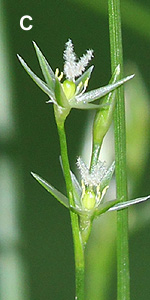 |
 |
 |
 |
|
Fig 1. Inflorescences of (A) sweet vernal grass; (B) Pennsylvania sedge; (C) Path rush; (D) wood-rush. |
|||
|
. ** Plant
Finder ** |
||||
| .Home | Start Over | |||
|
.About Grasses and Grass-like Plants |
||||
|
Got it! I already read this. Go to Graminoid key now. |
||
| Grasses, sedges and rushes are all "graminoids"; that is, grass-like, flowering, herbaceous (non-woody) plants. Their leaves are all extremely narrow, many times longer than wide, and have parallel veins. Though they are all monocots, they belong to three different plant families, respectively: Poaceae, Cyperaceae and Juncaceae. Other types of monocots include orchids, lilies, irises and onions. When seeds of monocots germinate, they send up only one seed leaf, rather than a pair of seed leaves (as is the case for dicots).
While
some
species
of
grass
are
valued
for
their
aesthetic
qualities
(ornamental
grasses),
most
graminoid
species
are
not
very
showy.
They
tend
to
have
small,
inconspicuous
flowers
that
are
borne
in
compact
arrangements,
hidden,
at
least
partially
by
minute
scales.
Flowers
of
most
graminoid
species
consist
mostly
of
male
and
female
reproductive
organs
enclosed
within
scale-like
bracts.
Rush
flowers,
which
have
green
or
brown,
chaffy
or
scale-like
"tepals",
are
the
exception
to
this
rule. |
||
 |
 |
 |
 |
|
Fig 1. Inflorescences of (A) sweet vernal grass; (B) Pennsylvania sedge; (C) Path rush; (D) wood-rush. |
|||
| . Our "key " to the graminoids is admittedly basic and simple, because graminoids require a greater level of technical knowledge than is appropriate for our purposes here. It isn't always possible to identify a graminoid plant by its leaves alone, for the leaves of many of these plants are very similar: long and narrow, with parallel veins and sheaths that surround the stem. Instead, one will often need to use a good-quality hand lens or even a dissecting microscope to examine characteristics of tiny scales, awns, ligules or fruit. This key will divide the graminoids into families: grasses, sedges and rushes. Within families, we will divide the species based on stem characteristics and gross characteristics of their inflorescences. For example, are the inflorescences narrow and very dense, or are they broad and open, with spreading branches. From there, you will click the image that most closely matches the plant you are trying to identify.
To
continue
with
the
key,
click
the
link
near
the
top
of
this
page. |
x
x
|
Images and text copyright Arieh Tal, 2017-2022. All rights reserved. ( Terms of Use ) |